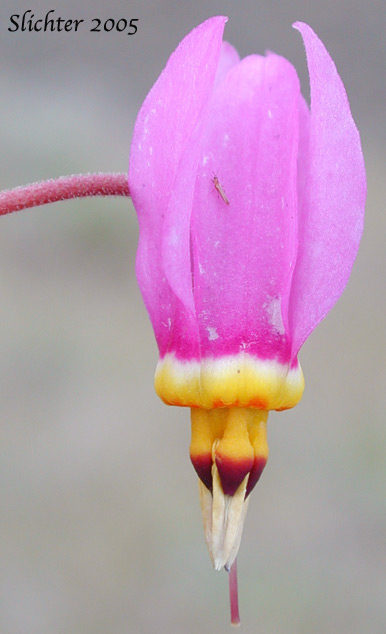Wildflower bloom along lower Deschutes River
April 24, 2005

Wildflower bloom along lower Deschutes River
April 24, 2005

 The
photo at right shows a close-up of the flower of Dodecatheon cusickii,
photographed on slopes above the Deschutes River near Ferry Springs.................April
24, 2005. Note the yellow filament tubes and the minute glands on the pedicel.
The
photo at right shows a close-up of the flower of Dodecatheon cusickii,
photographed on slopes above the Deschutes River near Ferry Springs.................April
24, 2005. Note the yellow filament tubes and the minute glands on the pedicel.
*1. Willow: Salix sp.-
*2. Bicolored Cluster Lily: Brodiaea howellii - A few in bloom.
*3. Pale Bastard Toad-flax: Comandra umbellata var. pallida - Fairly common.
*4. Heart-leaf Buckwheat: Eriogonum compositum var. compositum - Yellow flowered forms, just beginning to bloom.
*5. Miner's Lettuce: Claytonia (Montia) perfoliata - A few in bud higher on the canyon walls.
*6. Upland Larkspur: Delphinium nuttallianum - In bloom amongst bunchgrasses at middle to upper elevations.
*7. California Poppy: Eschscholtzia californica - At parking lot.
*8. Tumble Mustard: Sisymbrium altissimum - Fairly numerous in disturbed soils around the old railroad bed.
*9. Thick-leaf Thelypody: Thelypodium laciniatum var. laciniatum -
*10. Small-flowered prairie Star: Lithophragma parviflora - A few still in bloom.
*11. Northwest Saxifrage: Saxifraga integrifolia - Mostly long out of bloom except in shaded areas high on the canyon walls.
*12. Wax Currant: Ribes cereum - Plants still in bloom along the canyon rims.
*13. Hood River Milkvetch: Astragalus hoodianus - Fairly abundant.
*14. Spurred Lupine: Lupinus arbustus (Formerly L. laxiflorus and L. caudatus var. calcaratus I think!))- Abundant.
*15. Columbia Gorge Lupine: Lupinus latifolius var. thompsonianus - A few in bloom next to the old railroad bed.
16. Lance-leaf Scurf-pea: Psoralea lanceolata - In bud.
*17.V etch: Vicia sp. - At parking lot.
*18. Filaree: Erodium cicutarium - Moderate bloom.
*19. Pungent Desert Parsley: Lomatium grayii - Most plants are far past bloom, but those in shady, north-facing slopes of upper Ferry Springs Canyon are still in bloom.
*20. Slender-fruit Desert Parsley: Lomatium leptocarpum - A few in bloom.
*21. Bare-stem Desert Parsley: Lomatium nudicaule - Numerous plants.
*22. Nine-leaf Desert Parsley: Lomatium triternatum - Fairly common on the upper slopes amongst bunchgrasses.
*23. Cusick's Shooting Star: Dodecatheon cusickii - Numerous plants in bloom near Ferry Springs.
*24. Long-leaf Phlox: Phlox longifolia - Still fairly numerous.
*25. Silver-leaf Phacelia: Phacelia hastata - Fairly numerous.
*26. Tarweed Fiddleneck: Amsinckia lycopsoides - Drying up.
*27. Puccoon: Lithospermum ruderale - Fairly common, but going out of bloom.
*28. Common Monkeyflower: Mimulus guttatus - Beginning to bloom in moist areas along Ferry Springs Creek.
*29. Naked Broomrape: Orobanche uniflora var. purpurea - A few in bloom.
*30. White Plectritis: Plectritis macrocera - Mostly out of bloom, except in shaded areas high on the canyon walls.
*31. Yarrow: Achillea millefolium - Fairly numerous.
*32. Annual Agoseris: Agoseris heterophylla - Fairly common.
*33. Low Pussytoes: Antennaria dimorpha - Some still in bloom.
*34. Carey's Balsamroot: Balsamorhiza careyana var. intermedia - Multiple flower heads, the central one the largest. (There's a possibility B. deltoidea or B. sagitatta could be present too.)
*35. Hoary False Yarrow: Chaenactis douglasii var. douglasii - In bud.
36. Hawksbeard: Crepis species- In bud.
37. Thread-leaf Fleabane: Erigeron filifolius - Many plants with the rays just beginning to extend.
*38. Rabbit Leaf: Lagophylla ramosissima - A few in bloom at lower elevations.
*39. False Agoseris: Nothocalais troximoides (Microseris troximoides) - Fairly common on the highest slopes of the canyon.
Animals Seen: Osprey hazed by red-winged blackbirds, Canada Geese, Sea Gulls, Common Mergansers, Belted Kingfisher, Crop Duster, American Robin, Brewer's Blackbird, Red-winged Blackbird, Ravens, Ash-throated Flycatcher, Rock Wren, Yellow-rumped Warblers, Western Meadowlarks, Pheasant, Claifornia Quail, Western Fence Lizards, large black Carnivorous Ground Beetles, small blue butterflies, Painted Lady butterfly, Anise Swallowtail, Sarah's Orangetip butterfly, small Skipper, Jumping Spiders, numerous bee species, black and orange fuzzy caterpillars.